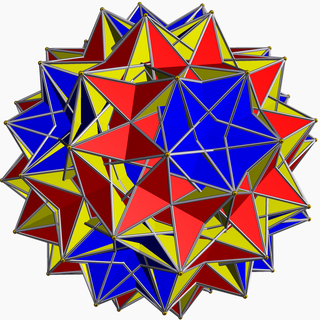| Great dirhombicosidodecahedron | |
|---|---|

| |
| Type | Uniform star polyhedron |
| Elements | F = 124, E = 240 V = 60 (χ = −56) |
| Faces by sides | 40{3}+60{4}+24{5/2} |
| Coxeter diagram | |
| Wythoff symbol | | 3/2 5/3 3 5/2 |
| Symmetry group | Ih, [5,3], *532 |
| Index references | U75, C92, W119 |
| Dual polyhedron | Great dirhombicosidodecacron |
| Vertex figure |  4.5/3.4.3.4.5/2.4.3/2 |
| Bowers acronym | Gidrid |

In geometry, the great dirhombicosidodecahedron (or great snub disicosidisdodecahedron) is a nonconvex uniform polyhedron, indexed last as U75. It has 124 faces (40 triangles, 60 squares, and 24 pentagrams), 240 edges, and 60 vertices.[1]
This is the only non-degenerate uniform polyhedron with more than six faces meeting at a vertex. Each vertex has 4 squares which pass through the vertex central axis (and thus through the centre of the figure), alternating with two triangles and two pentagrams. Another unusual feature is that the faces all occur in coplanar pairs.
This is also the only uniform polyhedron that cannot be made by the Wythoff construction from a spherical triangle. It has a special Wythoff symbol | 3⁄2 5⁄3 3 5⁄2, relating it to a spherical quadrilateral. This symbol suggests that it is a sort of snub polyhedron, except that instead of the non-snub faces being surrounded by snub triangles as in most snub polyhedra, they are surrounded by snub squares.
It has been nicknamed "Miller's monster" (after J. C. P. Miller, who with H. S. M. Coxeter and M. S. Longuet-Higgins enumerated the uniform polyhedra in 1954).
- ^ Maeder, Roman. "75: great dirhombicosidodecahedron". MathConsult.